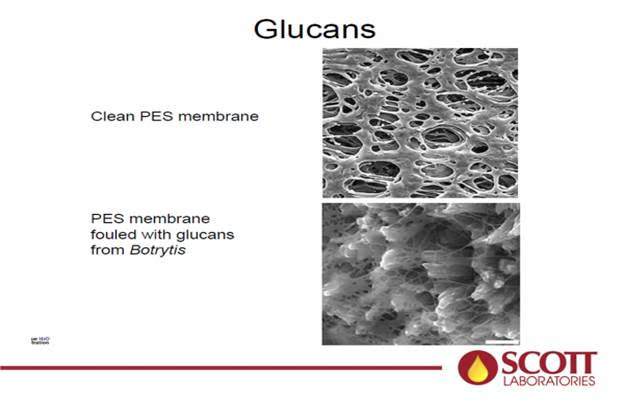Vintage 2019 MN grape wine filtering issue - UMN Grape Breeding & Enology Project
by Drew Horton, Enology Specialist
The University of Minnesota Grape Breeding & Enology Project has recently received anecdotal reports about difficulty in filtering vintage 2019 wines made from the Frontenac “family” of grapes: Frontenac, Frontenac gris and Frontenac blanc, and possibly some other grape varieties as well. Some winemakers have reported increased problems with filter and membrane clogging, especially with cross-flow type filters.
Although samples of difficult-to-filter wine have not yet been analyzed or measured, discussion with filtration expert Maria Peterson at Scott Labs reveal that this difficulty may be due to increased levels of beta-glucans, a large-molecule polysaccharide. Increased amounts of beta-glucans in juice and wine can be the result of vintage weather conditions that impact bacteria. In Minnesota, 2019 was remarkable for many rain events and high humidity levels, these conditions can lead to the growth of Botrytis and increased incidence of rogue bacteria like Pediococcus. The appearance and growth of these organisms can lead to increased amounts of beta-glucans and can occur during fermentation. This is not a factor just for hybrids, vinifera grapes can have the same issues for the same reasons.
Increased beta-glucans from Botrytis or Pediococcus can quickly plug filters or even the membrane media of a cross-flow. One might also see that tighter-grade sheets and lenticular-cartridges struggle to efficiently pass the wine. Careful monitoring is important since a pressure build-up could blow a hole in the membrane creating downstream problems such as bottling line membranes clogging too quickly.
The addition of enzymes that break down beta-glucans before aging, storage, and bottling can prevent future filtration problems. According to Maria Peterson, “I like adding a beta-glucanase like the Lallzyme MMX as par for the course on difficult batches.” The contact time to break up beta-glucans is at least 6 weeks, so an enzyme addition prior to maturation or bulk storage is advised. An additional benefit of an enzyme like MMX is that it also accelerates autolysis of yeast cells which can improve mouthfeel in the wine. Peterson cautions, “Waiting until bottling day to test for glucan content may be too late, especially in years with favorable conditions for glucan formation.” Professional laboratories can test for Botrytis and glucan content of juice and wine.
ETS Labs in California can test juice and wine for Botrytis and glucan content: https://www.etslabs.com/analyses/%23JBOTPAN
Enartis by Vinquiry Labs in California can also test juice and wine for Botrytis and glucan content:https://shop-usa.enartis.com/wine
Here is a link to the Lallzyme MMX enzyme product from Scott Labs’ website: https://scottlab.com/fermentation-cellar/enzymes/lallzyme-mmx-100g-016207?returnurl=%2ffermentation-cellar%2fenzymes%2f
Enartis by Vinquiry in California has a comparable product:
https://shop-usa.enartis.com/enartis-zym-elevage
